Hoof Casts
5-12-08
Pete Ramey
Copyright 2008
Special thanks to all of the American
Hoof Association members. The information in this article is the
product each member's experimentation and feedback. As a team,
we were able to evaluate the casting process on many horses in a
wide range of situations and environments, over time.
The Basic Need
After years of study, practice and the
comparison of various trimming and shoeing methodologies, I am
convinced that there is no better way to grow well-connected
walls onto flared or foundered horses than with routine,
competent barefoot trimming and careful attention to the horse’s
diet and lifestyle. This is also the best way I have seen to
build sole onto thin-soled horses, develop a healthier caudal foot for
navicular horses, grow out wall cracks and the best way to treat
and prevent hoof problems in general.
I am equally convinced that hoof boots can,
should and will be the 21st Century Horseshoe.
Boot quality and technology continues to improve every day, and
as better boots with a wider range of traction variations hit
the market, it will make less and less sense to limit the
options available to the horse and rider by attaching permanent
hoof protection or traction devices.
So with all the positives we have enjoyed
with natural hoof care theory and practice, there have also been
important negatives. The primary problem: Time. The competent
trimmer often knows a hoof problem can be easily grown out, but
it will take six months to grow a new hoof capsule. During this
time the horse might be tender-footed when it isn’t wearing hoof
boots. This is why I have been (and still am) such a strong
advocate of booting in general. Hoof boot turnout is spectacular
for the horse. The healing mechanics and comfort are simply
without equal anywhere in the farrier world, but it does require
work and dedication on the part of the horse owner; the
boots/hooves must be cleaned, treated and inspected every day to prevent
problems from excess moisture. Careful and constant scrutiny to
padding and boot fit is needed to prevent chafing of the skin.
This of course works extremely well for some people, but is an
impossibility or at least a 'deal-breaking aggravation' for
others and many horses that could have been truly healed are
instead stuck in a pattern of constant attempts to "patch up"
the existing damage.
I have constantly dreamed of and sought out a compromise. Actually compromise is the wrong word; I have wanted to “have my cake and eat it too.” We have desperately needed something that combines the healing mechanics of barefoot/boots with the convenience of horseshoeing. I (and many other trimmers and farriers) believe we have found it: Hoof casting. This is a tool so effective, it should be immediately added to every hoof professional's “bag of tricks.”
Typical 'open-soled' wrap recommended by Equicast (#2 foot with 2" cast
shown).
The "black stuff" on the cast is residue from the foam pad
that adhered to it during the curing/compression process 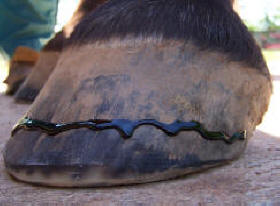
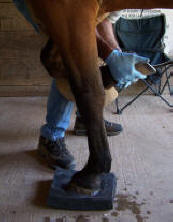

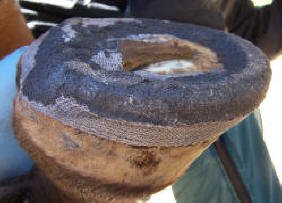
Equicast
Over the last 19
years, Dave Richards (
www.equicast.us
910-281-5658) developed Equicasts specifically for use on
horses’ hooves. The casting material is not the same as a
typical fiberglass cast. Instead it uses a unique poly-cloth and
resin combination that is far more durable, abrasion resistant
and more flexible than a typical cast. It also holds up well to
environmental moisture.The idea is simple on the
surface: You use the quick-drying material to build a
semi-permanent, ‘below the hairline’ custom hoof boot. Top
podiatry clinics have trusted them for years, but their common
use in the field has been limited. This should change. In
general the cast combines the protection and laminae-relieving
solar support of the padded hoof boot while it simultaneously
“holds the foot together” better than a horseshoe. Add vertical
flexion, heel expansion, pressure and release to the solar
corium (rather than dangerous static pressure), plus
little or no maintenance from the horse owner; this is a very
good tool.
There is a learning curve to using the
casts, but with a little experience they are easy to apply. Dave
has instructional videos and detailed written instructions on
his site that you will need to study, and I made a DVD set
Tools of the Trade
that shows variations in the field. But here are the basics:
1)
Trim and then thoroughly clean the foot
2)
Open the package and remove the roll of casting
material.
3)
Place the roll in a bucket of water (for about
10 seconds- just enough time to do step 4).
4)
Apply a bead of Vettec Adhere to the hoof wall
(I prefer about one inch above the ground). For upright or
non-flared hooves use a zig-zag pattern, applying 3x more glue.
Alternately, people have succeeded with pre-wrapping the foot in
either Mueller’s Athletic Tape or Elasticon, rather than using
glue.
5)
Squeeze the excess water out of the cast, then
wrap the foot, keeping it off the coronet as you go. This part
takes a bit of finesse and experience to do well. Dave provides
practice casts with no resin to practice your wrapping
technique.
6)
Place the wrapped foot onto a foam pad (to mold
it to the bottom of the foot) and pick up the opposite foot to
expand the hoof capsule [apparently KC LaPierre has
placed a "provisional patent pending" on standing the horse on
foam pad during this process].
7)
I like to also immediately move the horse
before full curing to further increase hoof and cast expansion.
The cast will be dry in about two minutes. Cure time varies with
temperature and humidity. Cindy Sullivan
www.tribeequus.com reports
that the water temperature is a big deal. Cold water gives more
curing time, hot water gives a much faster curing time. Cold
water can be beneficial to slow down the curing time in hot
weather. Hot water speeds curing time, which can be beneficial
in cold weather).
8)
Trim away any material that is touching the
coronary band.
The results are extraordinary (no I am not
on Dave’s payroll). It is amazing how well it makes horses feel
– particularly horses with severe wall separation, thin soles,
and/or laminitis. I routinely use them for the first few weeks
after pulling shoes (if the soles are thin or the feet are
tender for turnout) and then let the horse go bare and fit
riding boots as usual when the horse is ready.
Potential problems?
Even though I saw immediate benefit, I was
very quiet about using them for a while. I was concerned about a
few possible problems:
1)
I was concerned that the casts might reduce
hoof flexion, restrict blood flow and lead to heel contraction
and/or slow healing.
I believe that the most important reducer
of hoof flexion and circulation is lameness – a lack of movement
or worse: compensative movement. No doubt the presence of the
cast robs some of the flexion of the hoof capsule, but the casts
tend to make compromised horses so comfortable, the increase in
correct movement seems to create an excellent
“circulatory trade-off.” In the real world, the foot is
healthier overall when you remove a cast. Well-connected wall
growth and healthy laminae will have been produced and the sole
will be thicker (from what I’ve seen, every time).
Granted, I do tend to only make 6-7 wraps
with the cast, usually wasting half of the roll per foot. I also
use the casts in two week cycles. I pull off an old cast at two
weeks, evaluate the situation, and then decide whether there is
a need to go another two weeks in the casts. Although it is more
rigid at first, a cast that has been used for two weeks is very
pliable. It is more like heavy cloth than a rigid cast. This is
probably a very important feature to their success.
The fact that the cast does reduce hoof
flexion to an extent can actually work in your favor. It is very
common for domestic horses to have under-developed digital
cushions and lateral cartilages. The weakness and instability
causes them to incorrectly impact on their toes. They can move
this way for a lifetime and never develop the back of the foot.
The stability of the cast often breaks this pattern and allows
the horse to comfortably impact heel first, starting the process
of developing the internal structures of the back of the foot.
2)
I was concerned that the cast might
excessively weaken/soften the foot and lead to problems with
fungal infection in the frogs and white lines.
The cast breathes. In my testing process, I
have used them for 3-6 week intervals in wet, muddy turnout
conditions with no significant problems with fungal infection or
excess moisture. I do believe that no form of hoof protection
could be healthier than being barefoot, IF the current
health and conditions allow comfortable and correct movement. If
not, the casts are a very useful tool with minimal negative
effects. When you first remove a hoof cast, the sole and frog
will be soft and unconditioned, but typically undamaged. Because
of this softness and lack of callus, I expect to need hoof boots
for riding at first, but have not seen any further
complications.
Added in 2018: prior to covering the bottom
of the foot with any fixed protection, pack the central and
collateral sulci with Artimud from Red Horse Products.
3)
I was concerned that they might be
over-used, becoming just another style of permanent horseshoeing
that ultimately degrades the health and quality of the foot over
time. “Use it or lose it” is nature’s law.
This one, I still worry about. It made me
very slow to publicly endorse hoof casting in general. So far I
have seen nothing but excellent results, but the longest I have
ever used them was for 6 weeks (3 two-week applications back to
back). Every other case was ready for barefoot turnout and/or
booted riding within 4 weeks. I suspect that long-term,
back-to-back use would start to degrade the foot over time (I
believe this would be the case with ANY form of permanent hoof
protection). I use them as a transitional tool with great
success, but feel they should probably remain a transitional
tool – a temporary measure to get the horse past a bad
situation.
Variations
Once you start working with hoof casting
and epoxies, your own imagination is the limit. I’ll discuss
some basic variations I have seen success with:
The manufacturer recommends an open-soled
wrapping method (shown above). The cast covers the lower half of
the hoof wall and laps over the white line and then covers about
3/4 inch of the outer perimeter of sole (2 inch casts will work
on most ‘non-draft’ horses). With this method, most of the sole
and half of the frog are exposed. This method works very well
when there is adequate sole thickness, and the primary concern
is lamellar integrity or caudal foot pain. This is my personal
favorite method for most laminitic horses, particularly in the
acute stage.
When soles are thin or when subsolar
abscessing is present, I typically use a wide (4-inch) cast to
create a boot that completely covers the bottom of the foot. The
cast alone is sometimes adequate for these horses, but usually I
prefer to add some type of pad to the bottom of the foot. When
you use this method, be sure to load the foot onto a firm pad or
pile of sand to compress cast wrinkles on the bottom of the
foot. Then after the cast cures, use a sharp hoof knife (as if
paring a sole) to further remove any bumps in the material that
could cause dangerous pressure points.
I have used Easycare Comfort Pads and Dome Pads (
www.easycareinc.com ) in the casts with great success. The easiest way to do this is to first glue the pad to the foot with Vettec Superfast. While the glue dries, let the pad fully compress (by holding up the opposite foot), then wrap the cast as usual. This provides the best comfort of any method I've tried, but reduces cast life. The casts tend to fall off at around 2 weeks, because the foot moves up and down in the cast, breaking the glue bond.Another excellent option is to create a
custom pad with Equi-Pak Soft. The worthwhile result is a
much cleaner environment between the foot and the pad. For this
method you will need access to the bottom of the foot for about
two minutes (as opposed to a few seconds for a foam pad), so
this is important for deciding which to do in a given situation.
Detailed instructions are available from Vettec, but the basics: To form the pour-in pad, thoroughly clean and dry the foot, and then apply the urethane to the bottom of the foot, filling in the solar concavity, collateral groves and frog sulcus. Once the product is applied through the mixing tip, it will set up in a minute or two (depending on temperature and humidity). During this time, place a piece of wax paper over the pad so you can use your fingertips to smooth, shape and control it as it dries. If the back of the foot is deep or contracted, a temporary duct tape “dam” at heel level (around the bulbs) is very useful. Once the product partially sets up, you can leave the wax paper in place and place the foot on flat ground to let the horse rest. When the epoxy hardens to a rubbery consistency, remove the wax paper and wrap the cast as usual.
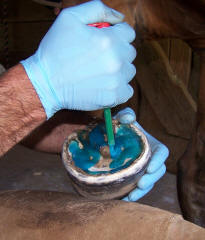
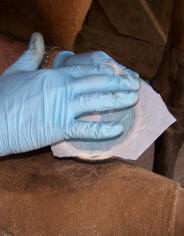
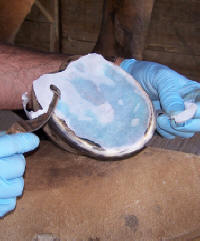

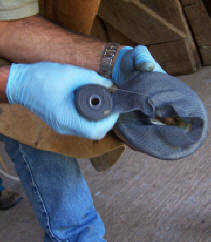
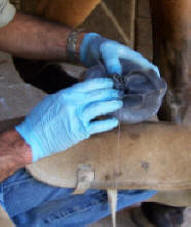
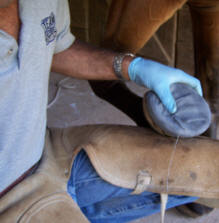

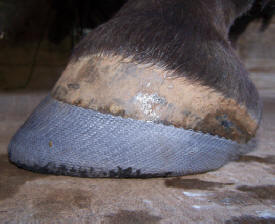
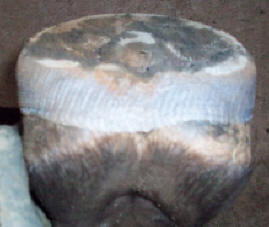
Creating a pad with Vettec Equethane CS and a full coverage cast for thin-soled horses (#2 foot with 4"cast shown).
2016 Edit: These days, I tend to shy away from the CS, preferring the softer Equi-Pak Soft or Dental Impression Material. To combat fungi and bacteria, I prep the bottom of the foot - particularly in the central and collateral sulci - with Evo Thrush.
Another great
trick is to do anti-fungal/anti-bacterial soaks through the
cast. This is especially helpful with P3/sole penetrations,
subsolar abscesses, thrush and white line disease. Personally I
use 1 hour soaks (buy soaking boots) with a 50/50 water/apple
cider vinegar solution. I have also talked to other
professionals who have successfully used White Lightening and
Clean Trax with no harm done to the casts. Just be sure the
soaking solution doesn’t harm live tissue. This is particularly
important because the cast may hold the solution next to the
foot longer than you think.
These methods and more can be combined to
maximize comfort and healing dynamics for the toughest of cases.
One of the first horses we worked with the casts was a 4 year
old Thoroughbred with zero sole depth (most of
the solar papillae at the toe had been exposed by the previous
farrier’s rasp), full sole penetration at the toe, a 1/2-inch
distal descent of P3 and subsolar abscessing.
This is a most challenging type of case. If
you peripherally load the horse in an attempt to unload the open
wounds under P3, there is no vertical support of the skeleton
(the whole horse is hanging from the already compromised
laminae). The horse will continue to sink through the hoof
capsule. On the other hand, if you load P3 on the corium (with
no sole present), circulatory disruption and tissue death are
inevitable. Putting our heads together with the attending
veterinarian, the casting material, epoxy and a bit of
imagination allowed us to come up with a life-saving solution.
There was still adequate sole depth in the back of the foot, so
we created caudal support with the Equi-Pak, leaving the wounds
at the toe open. We then applied the cast to ‘hold the laminae
together’ and hardened it on a flat surface so that it did not
make contact with the open wounds. We then had the barn manager
soak daily (ACV/Water) through the casts to prevent further
infection.
To our surprise, the horse walked off
comfortably, and when we pulled off the casts two weeks later,
the horse had produced 1/2-inch of new sole. The bottom of the
foot had been protected well enough to prevent further damage
and wear, but stimulated enough to produce an incredible amount
of new sole. Now the horse (previously immobile in bar shoes and
pads) is comfortable barefoot and the distal descent is steadily
reversing.
Another useful variation can provide more
working time to the process when needed. The cast can be wrapped
first, and then the water can be rubbed into the cast
afterwards. This slows curing time. I have used this to add
additional hoof/cast expansion by walking the horse, and also to
occasionally get two feet done with one roll (Yes I have
tightwad tendencies- sorry Dave). This method also provides
better glue adhesion, so it is the method of choice for upright
feet with no wall flaring.
Another good trick is to quickly wrap the cast in plastic wrap
before curing. This allows less glue to bubble out and yields
better abbrasion resistance.
When I (and my colleges in the
American Hoof Association) first started experimenting with the casts as a group, we had high hopes for their use for riding. While a horse certainly can be ridden in the casts, with the weight of a rider they wear out quickly in rocky terrain, even with epoxy reinforcement. So the hoof boot remains our tool of choice for riding, but the casts have proven themselves beyond question for rehabilitation and turnout.Please read the other articles on
www.hoofrehab.com and watch the DVD Series- Under the Horse for detailed trimming information.Special Trimming Considerations
When a horse is to wear a hoof cast, I
essentially trim the foot as if it were to be bare/booted, with
a few minor exceptions. When barefoot horses are sensitive in
the back of the foot, I typically leave the heels longer (up to
1/2-inch past the callused sole plane). The idea is not to lift
the frog off the ground, but to slightly reduce the pressure on the
over-sensitive frog (as the heel sinks into terrain) so that the
horse will be comfortable enough to impact the ground
heel-first, loading the frog an amount they can currently bear. The cast effectively relieves frog pressure enough
that leaving this extra heel length is generally not necessary
and usually not desirable. In short, I have a greater tendency
to simply lower the heel to the callused sole plane if the horse is to
wear a cast.
Also, with severely flared walls, I tend to
be slightly more aggressive with the roll/bevel on the outer
wall if I plan to use a cast. It is difficult to generalize
(every horse is different) but if a given horse would need a
flared quarter wall left 1/8-inch longer than the sole plane to
be comfortable, you could get by with rendering the quarter wall
slightly passive to the sole if using a cast. The result is a
greater ability to grow out wall flares without causing
discomfort.
I consider the application of hoof casts to
be for experienced professionals only. An improperly
applied cast could cause serious problems. A cast left on too
long could wear through at ground level and slide up the leg,
damaging the coronet. A cast wrapped too tight or not
double-loaded during curing could rob circulation. A lump of
glue or casting material left on the sole could cause damage to
the solar corium. The duration
and method used requires careful consideration of many factors.
I have been impressed with the results, though, and I firmly
believe that every farrier and trimmer should immediately add
this to their bag of tricks.
When starting out, my advice is to get
several extra casts to apply to your own horses while no one is
looking. Your learning curve will be vertical at first and you
will make mistakes. It is best that you are not learning to wrap
while also struggling to access a lame horse, and frankly it is
also best that the vet and horse owner are not looking over your
shoulder while you botch a few casts and get glue stuck to every
hair on your arm from the elbows, down.

